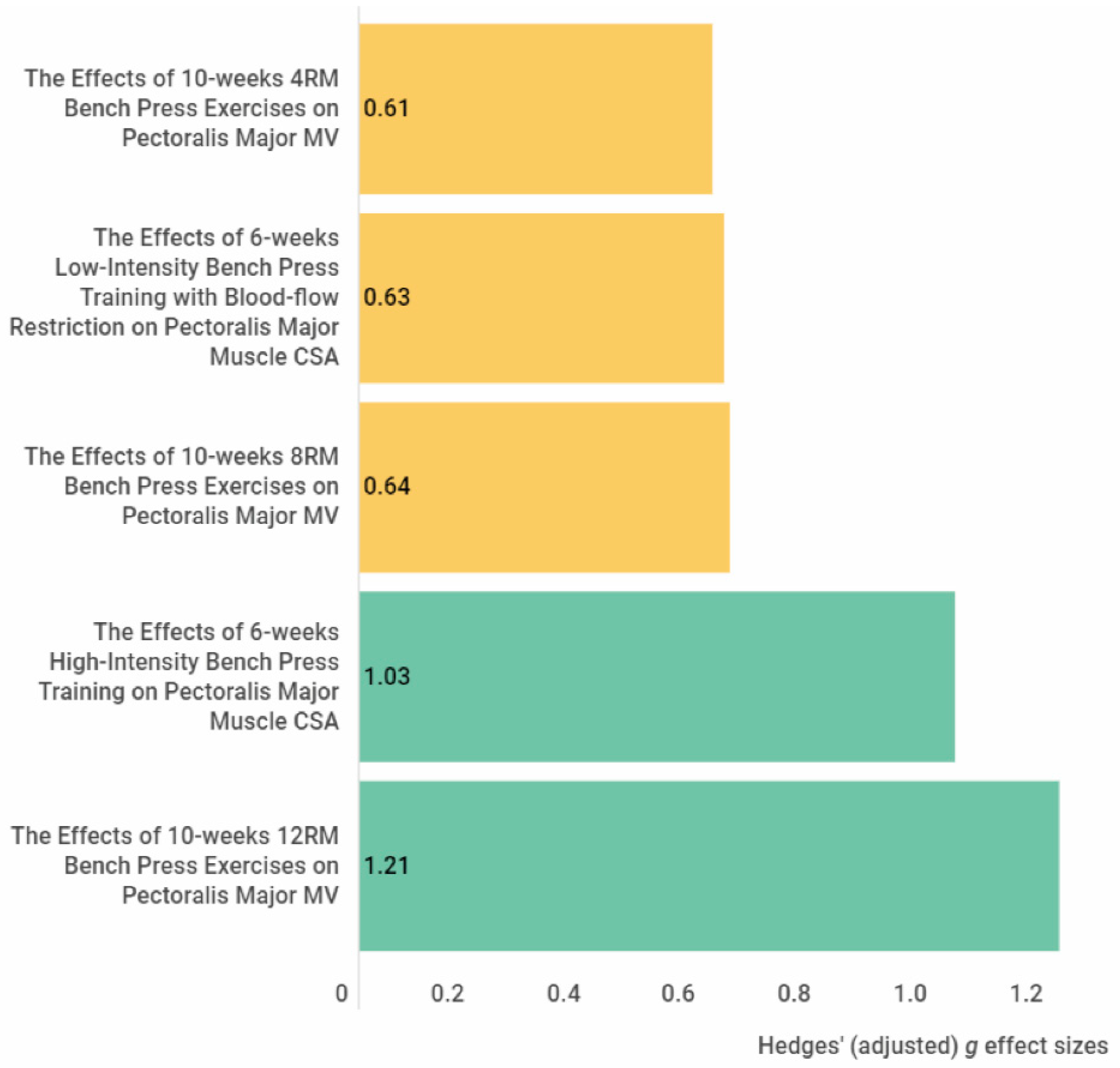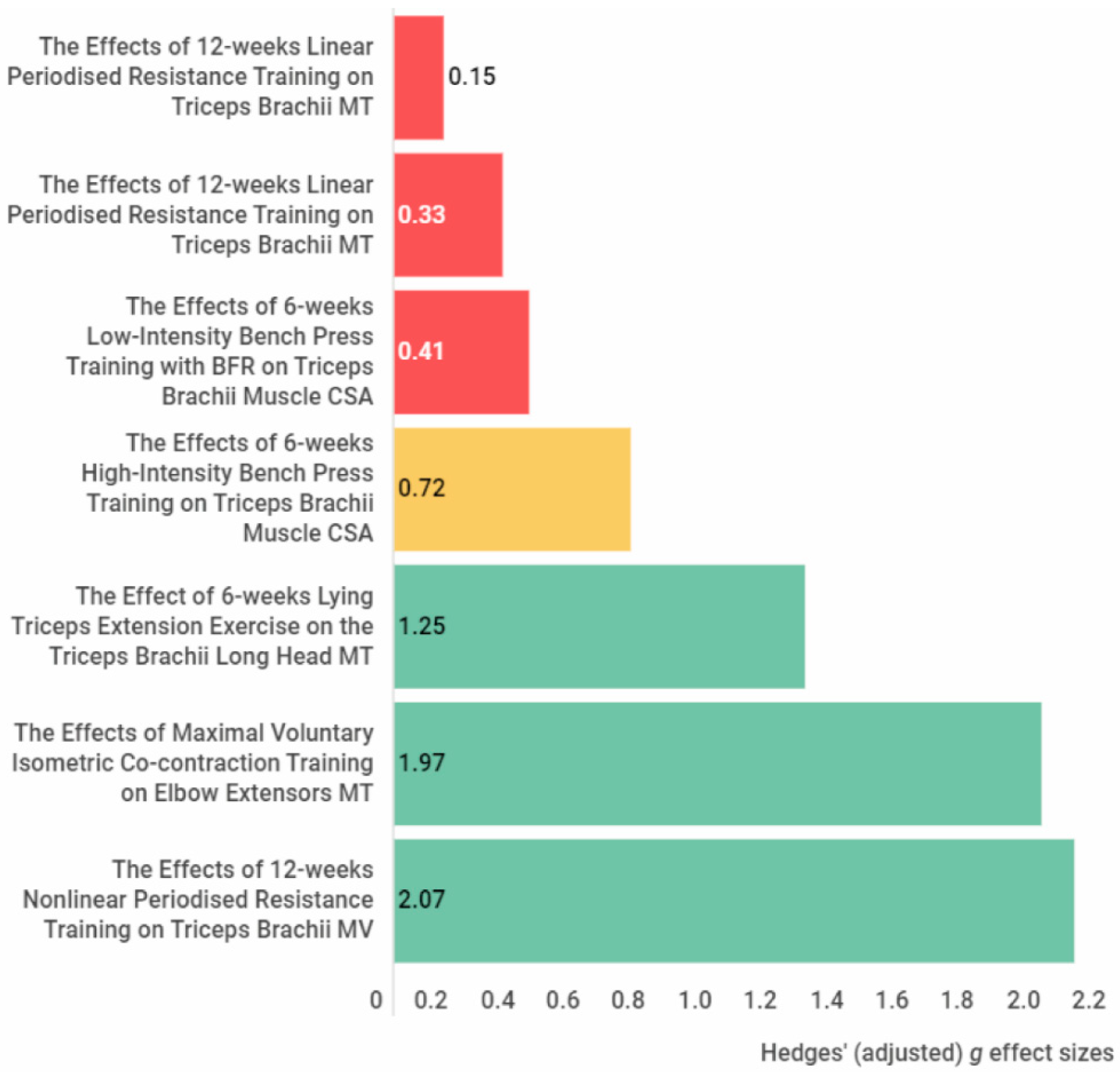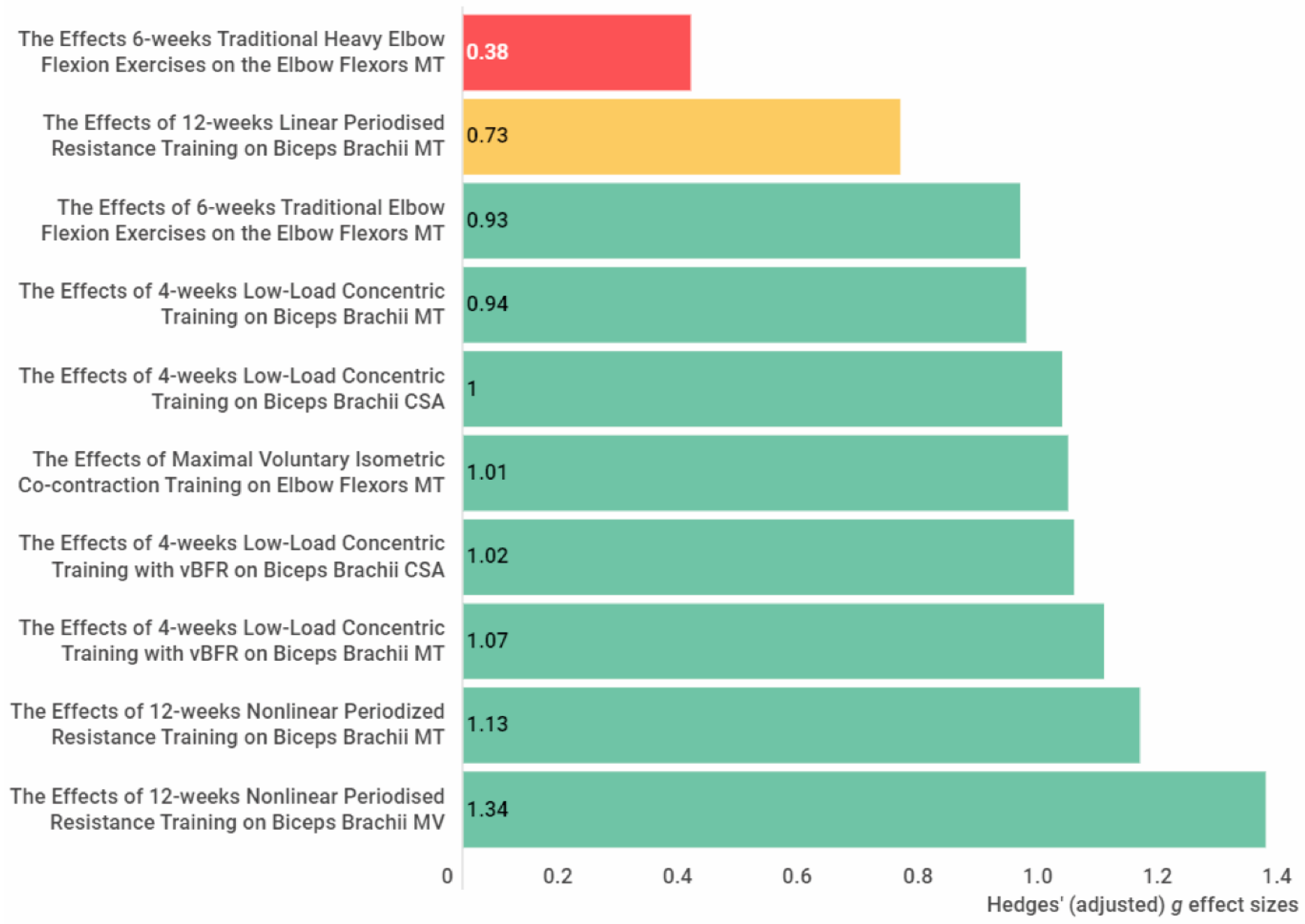1. Introduction
Training-induced muscle adaptations are one of the core elements in training strategies for players, coaches, sports teams, sports federations or non-athletes. The number of studies focusing on muscle architecture has increased due to increasing access to technology for non-invasive muscle visualisation methods, e.g., magnetic resonance imaging (MRI) and ultrasound measurements. For example, investigating relationships between muscle architectural parameters and sports performance, muscle strength or sports injuries, and adaptations resulting from training, detraining, bed rest, or micro-gravity has received attention from researchers. Approximately 65% of PubMed database records containing the term “muscle architecture” have been published in the last decade.
The term muscle architecture has a broad definition in the literature and includes the anatomical cross-sectional area (ACSA) and physiological cross-sectional areas (PCSA) of muscles, fascicle length (FL), muscle thickness (MT), muscle length and pennation angle (PA) [
1]. These skeletal muscle architectural parameters identify the functional traits of a muscle [
2]. Studies revealed that muscle architectural parameters are predictors of strength [
3,
4,
5,
6,
7,
8,
9,
10,
11,
12,
13,
14], athletic performance [
15,
16,
17,
18,
19,
20,
21,
22,
23,
24,
25,
26] and athletic injuries [
27,
28,
29,
30,
31,
32,
33,
34].
The upper extremity muscles include muscles involving shoulder joint movements, e.g., rotator cuff muscles, the pectoralis major muscle, and the deltoid muscle; arm muscles, e.g., biceps brachii and triceps brachii; forearm muscles, e.g., flexor and extensor carpi ulnaris, flexor and extensor carpi radialis; and hand and wrist muscles, such as palmaris brevis, lumbrical muscles, hypothenar and thenar muscles [
35]. Muscle size parameters of the upper extremity muscles are strongly correlated with better lifting (r = 0.77–0.91) [
17], swimming (r = −0.56) [
36], rowing (r
2 = 0.195) [
37], and shot put performances (r = 0.68) [
38]. Additionally, the upper extremity muscle sizes are significantly correlated with the upper extremity strength parameters such as elbow joint torque (r = 0.705–0.945) [
39], elbow flexion maximal power (r = 0.81) [
40], elbow extensor strength (r = 0.7–0.78) [
41], finger extension force (r
s = 0.85) [
42], bench press strength (r = 0.866) and bench throw peak power (r = 0.821) [
43], and shoulder external rotation strength (r = 0.287) [
44]. Regarding the upper extremity muscles’ fascicle geometry, the triceps brachii FL is one of the best predictors of better 200 -m front crawl swimming time (r
2 = 0.392) [
36] and significantly correlated with better swimming (r = −0.64) [
36] and lifting performances (r = 0.45–0.52) [
17]. The triceps brachii PA was significantly correlating with elbow extension strength parameters (r = 0.471–0.563) [
45].
Training-induced muscle architectural changes may depend on the exercise’s contraction type. Eccentric (lengthening) and concentric (shortening), and isometric training can lead to comparable hypertrophic responses in skeletal muscles [
46,
47]. Kawakami et al. [
48] noted muscle size increments are accompanied by pennation angle increases in hypertrophied muscles. By comparison, Franchi, Reeves, and Narici [
46] highlighted that the underlying myogenic and molecular responses may be different in eccentric and concentric muscle actions because the eccentric training is considered to favour increases in fascicle length, and concentric training to favour higher increments of pennation angle [
46]. A recent study by Pincheira et al. [
49] showed that eccentric training can increase fascicle length by increasing sarcomere lengths. Another study stated that concentric, eccentric and isometric exercises can lead to similar increases in total DNA and RNA quantities, which are representative of muscle hypertrophy; however, concentric and isometric training increases muscle insulin-like growth factor 1 mRNA levels, whereas eccentric training does not increase these levels [
46]. In short, there may be different underlying myogenic and molecular mechanisms of different training-induced muscle adaptations depending on the contraction type.
In consideration of the importance of the architectural parameters of upper extremity muscles for strength, power, rate of force development and sports performance, screening training-induced adaptations in the architecture of the upper extremity muscles may be a reference point for future training and conditioning directions for both athletes and non-athletes who target the upper extremities.
2. The Effects of Resistance Training on Architecture and Volume of the Upper Extremity Muscles
It is revealed that most exercise interventions with at least 4-weeks of exercise duration showed large effect sizes for increasing the size of individual upper extremity muscle or muscle groups (Figure 25, Figure 26, Figure 27 and Figure 28). In summary, the following exercises showed large effects on increasing the size of the targeted muscles: high-intensity concentrically-biased bench press training for the pectoralis major; lying concentrically-biased triceps extension, isometric maximal voluntary co-contraction training, and nonlinear periodised resistance training for the triceps brachii; traditional concentric elbow flexion exercise, low-load concentric forearm flexion-extension training without and with blood-flow restriction, isometric maximal voluntary co-contraction training, and nonlinear periodised resistance training for the biceps brachii; and isometric ulnar deviation training for the flexor carpi ulnaris and radialis.
 Figure 25.
Figure 25. The effect size of the exercise interventions on the pectoralis major muscle cross-sectional area and volume. The yellow colour indicates a medium effect size, and the green colour indicates a large effect size. Abbreviations: CSA, cross-sectional area, MV, muscle volume.
 Figure 26.
Figure 26. The effect size of the exercise interventions on the elbow extensor muscle thickness, cross-sectional muscle area and muscle volume. The red colour indicates a small or trivial effect size, the yellow colour indicates a medium effect size, and the green colour indicates a large effect size. Abbreviations: CSA, cross-sectional area; MT, muscle thickness; MV, muscle volume.
 Figure 27.
Figure 27. The effect size of the exercise interventions on the elbow flexors muscle thickness, muscle cross-sectional area and muscle volume. The red colour indicates a small or trivial effect size, the yellow colour indicates a medium effect size, and the green colour indicates a large effect size. Abbreviations: CSA, cross-sectional area; MT, muscle thickness; MV, muscle volume.
 Figure 28.
Figure 28. The effect size of the exercise interventions on the forearm flexors muscle thickness. The green colour indicates a large effect size. Abbreviations: MT, muscle thickness.
In addition to the training modalities included in the meta-analyses, six RCTs [
75,
76,
80,
81,
82,
87] were not included due to missing outcome data. Among these RCTs, Matta et al. [
85] investigated the effects of a nonlinear periodised strength training program on biceps brachii and triceps brachii MT and the triceps brachii long head PA and reported significant alterations in the outcome measures depending on the arm sites. The study of Matta et al. [
85] was the only RCT that measured the PA of a muscle, which is a fascicle geometry component, among the eligible RCTs. The triceps brachii long head PA was significantly correlated with the strength parameters of the elbow extensors [
45]. By comparison, the triceps brachii long head FL was one of the best predictors of a better swimming performance [
36] and significantly correlated with lifting performance parameters [
17]. However, there was no RCT that investigated the effects of an exercise intervention on the FL of triceps brachii long head. Although it did not meet the inclusion criteria of this systematic review, a recent uncontrolled trial [
93] compared the effects of concentrically-biased cable push-down and cable overhead extension exercises, and Stasinaki and colleagues [
93] did not report significant alterations in the FL of the triceps brachii long head even when the concentric elbow extension starts from a fascicle lengthened position. This may be due to the effects of concentric training. A future RCT should examine the impacts of eccentric training on the FL of triceps brachii long head.
In terms of the muscle size parameters, the triceps brachii MT has been found to be strongly correlated with elbow extension strength [
41]. Additionally, the triceps brachii MT was stated as being significantly correlated with better swimming performance (r = −0.56) [
36]. Moreover, elbow extensors’ and flexors’ muscle size parameters (ACSA, PCSA and MV) showed significant strong correlations with elbow joint torque (r = 0.705–0.945) [
39]. Furthermore, the elbow extensors’ cross-sectional muscle area (CSA) was correlated with rowing performance, and was the significant best predictor of arm pull during the rowing activity in rowers (r
2 = 0.195) [
37]. Elbow flexors CSA showed a strong correlation with elbow flexion maximal power (r = 0.81) [
40]. Arm muscles CSA was significantly correlated with shot put performance (r = 0.68) [
38]. The pectoralis major muscle CSA was strongly correlated with bench press strength (r = 0.866), and muscle volume was strongly correlated with bench throw peak power (r = 0.821) [
43]. Either concentric, isometric, eccentric or blood-flow restricted resistance training modalities led to significant muscle hypertrophies. Based on these findings, athletes, healthy individuals aiming to increase their related performance or muscle strength parameters, astronauts after a space mission [
94] and patients experiencing muscle atrophies after bedrest [
95,
96], which were mentioned above, may refer to the training regimens that showed large effects sizes on increasing the pectoralis major, arm and forearm muscles’ size parameters. However, exercise selection should cautiously be made due to the small numbers of studies included in each meta-analysis.
Additionally, the infraspinatus MT was significantly correlated with shoulder external rotation strength in professional baseball pitchers (r = 0.287) [
44]. The subscapular MT was the best single predictor for powerlifting performance in professional powerlifters [
17]. However, this systematic review did not detect any RCTs focusing on exercise-induced alterations in these muscle architectural parameters. Future RCTs may be conducted to investigate exercise-induced alteration in these muscle architectural parameters in the relevant samples, such as exercise-induced alterations in the infraspinatus MT in baseball pitchers, in the subscapular MT in powerlifters, and in the fascicle geometry of the triceps brachii in swimmers.
3. Conclusions
Regarding the pectoralis major muscle size, 6-weeks of high-intensity bench press training [
91] and 10 weeks of 12 RM bench press exercises [
82] can be applied for hypertrophy in this muscle. To achieve hypertrophy in elbow extensors, 6-weeks of lying triceps extension exercise [
76], isometric maximal voluntary co-contraction training [
83,
84], and 12-weeks of nonlinear periodised resistance training [
89] may be a suitable intervention. From the perspectives of elbow flexors, 6-weeks of traditional elbow flexion exercises [
77], 4-weeks of concentric low-load forearm flexion-extension training [
79], isometric maximal voluntary co-contraction training [
83,
84], 4-weeks of concentric low-load forearm flexion-extension training with vBFR [
79], or 12-weeks of nonlinear periodised resistance training [
88,
90] can be applied to gain hypertrophies in the elbow extensors. Finally, 6-weeks of isometric ulnar deviation training can be used to increase the flexor carpi ulnaris and radialis muscle size [
78].
However, these results should be cautiously interpreted due to the small numbers of the RCTs included in each meta-analysis. More RCTs are needed to provide more precise and more robust conclusions about the effects of exercise on the architecture of the upper extremity muscles. Additionally, all the eligible studies of this systematic review were restricted to muscle size measurements, and not did not expand towards the fascicle geometry such as the FL of the triceps brachii long head. Future RCTs can examine the effects of exercise on the triceps brachii FL and PA, the infraspinatus MT and the subscapular MT, due to their associations with sports performance.
 Figure 25. The effect size of the exercise interventions on the pectoralis major muscle cross-sectional area and volume. The yellow colour indicates a medium effect size, and the green colour indicates a large effect size. Abbreviations: CSA, cross-sectional area, MV, muscle volume.
Figure 25. The effect size of the exercise interventions on the pectoralis major muscle cross-sectional area and volume. The yellow colour indicates a medium effect size, and the green colour indicates a large effect size. Abbreviations: CSA, cross-sectional area, MV, muscle volume. Figure 26. The effect size of the exercise interventions on the elbow extensor muscle thickness, cross-sectional muscle area and muscle volume. The red colour indicates a small or trivial effect size, the yellow colour indicates a medium effect size, and the green colour indicates a large effect size. Abbreviations: CSA, cross-sectional area; MT, muscle thickness; MV, muscle volume.
Figure 26. The effect size of the exercise interventions on the elbow extensor muscle thickness, cross-sectional muscle area and muscle volume. The red colour indicates a small or trivial effect size, the yellow colour indicates a medium effect size, and the green colour indicates a large effect size. Abbreviations: CSA, cross-sectional area; MT, muscle thickness; MV, muscle volume. Figure 27. The effect size of the exercise interventions on the elbow flexors muscle thickness, muscle cross-sectional area and muscle volume. The red colour indicates a small or trivial effect size, the yellow colour indicates a medium effect size, and the green colour indicates a large effect size. Abbreviations: CSA, cross-sectional area; MT, muscle thickness; MV, muscle volume.
Figure 27. The effect size of the exercise interventions on the elbow flexors muscle thickness, muscle cross-sectional area and muscle volume. The red colour indicates a small or trivial effect size, the yellow colour indicates a medium effect size, and the green colour indicates a large effect size. Abbreviations: CSA, cross-sectional area; MT, muscle thickness; MV, muscle volume. Figure 28. The effect size of the exercise interventions on the forearm flexors muscle thickness. The green colour indicates a large effect size. Abbreviations: MT, muscle thickness.
Figure 28. The effect size of the exercise interventions on the forearm flexors muscle thickness. The green colour indicates a large effect size. Abbreviations: MT, muscle thickness.